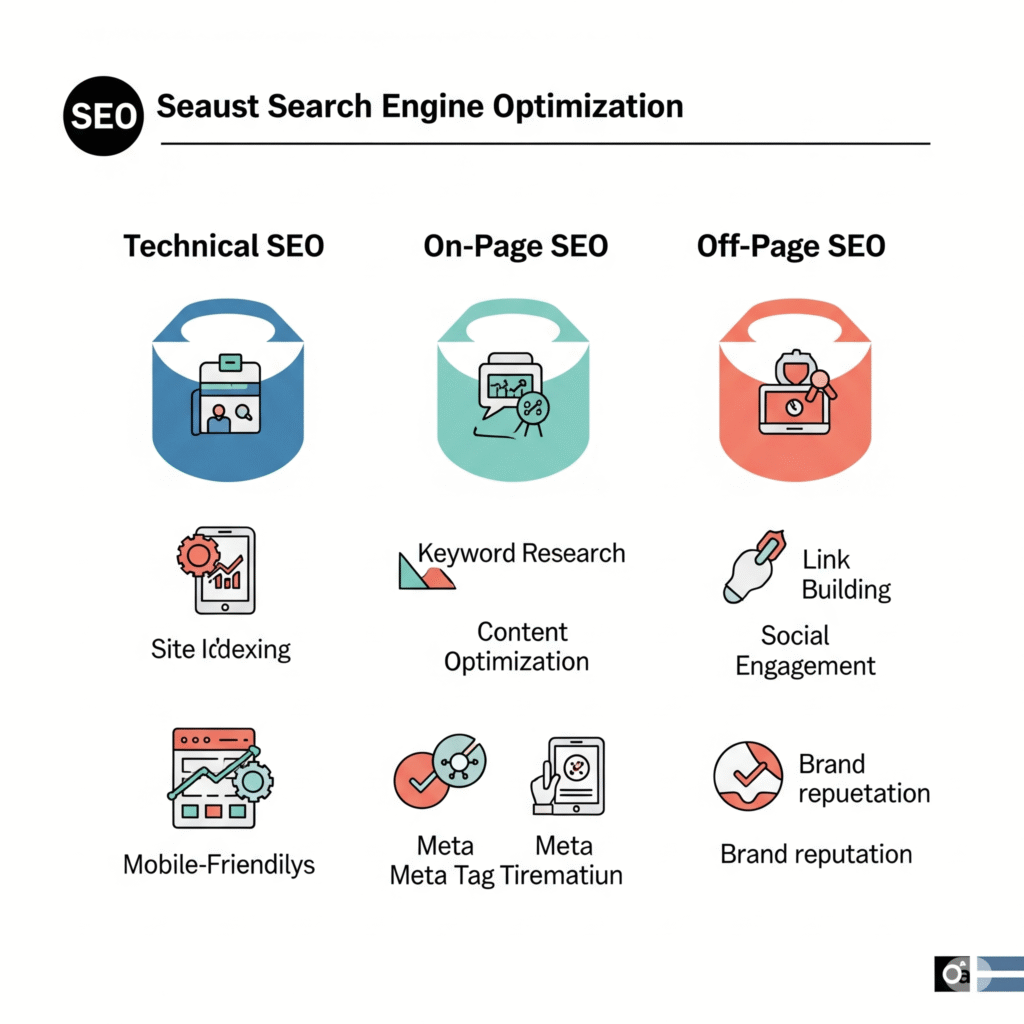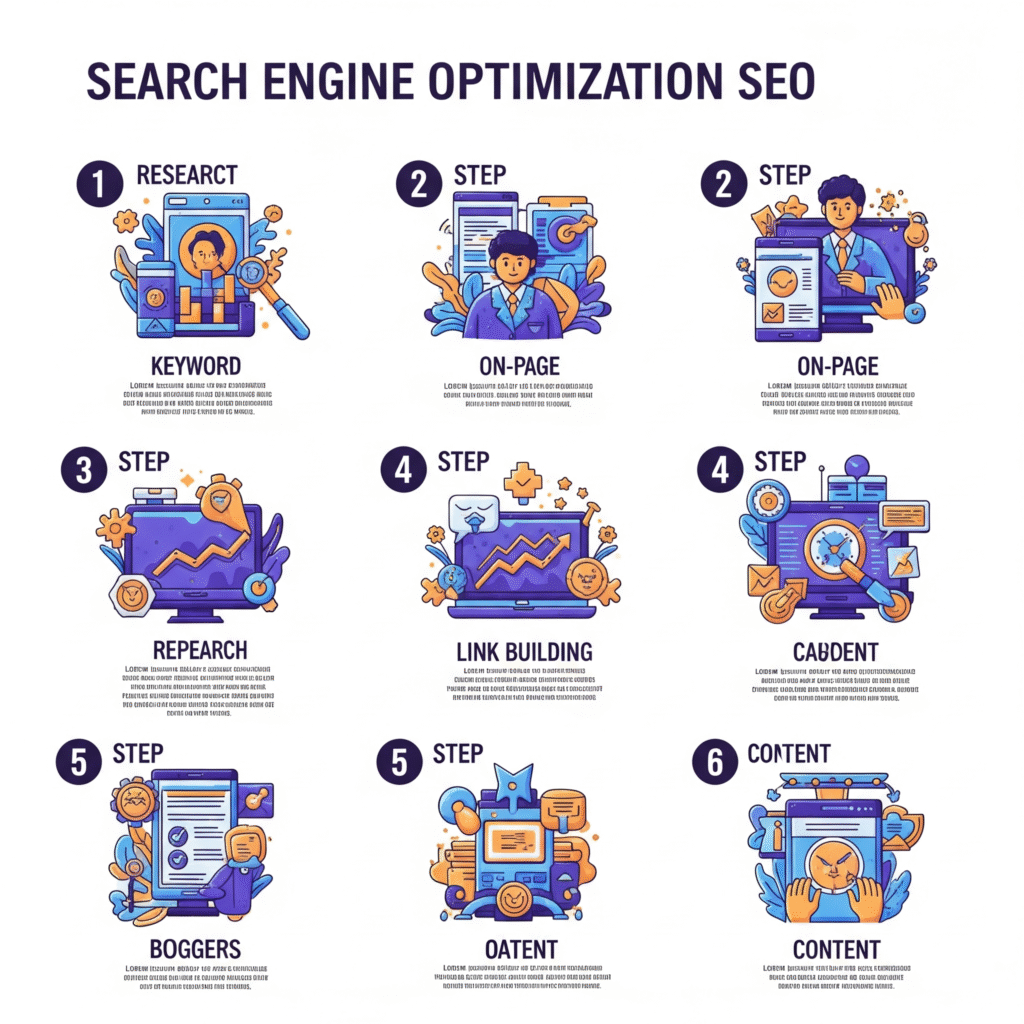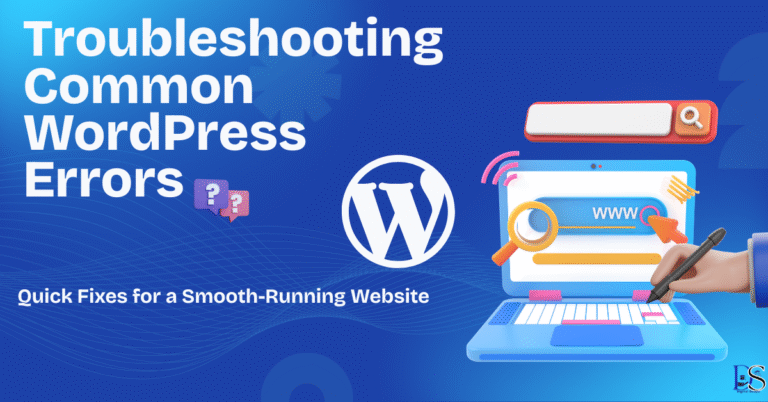Search Engine Optimization (SEO): Boost Website Visibility with Simple Strategies
If you’ve ever wondered how some websites effortlessly appear on the first page of Google while others stay buried, the answer lies in Search Engine Optimization (SEO). This guide breaks down SEO in plain English and shows you how to implement it, step by step—even if you’re not a developer or digital marketing expert.
Whether you’re starting a blog, running an online store, or managing a business site, SEO is the smartest, most cost-effective way to get discovered online.
Introduction
Search Engine Optimization is the process of improving your website so that it appears higher in search engine results pages (SERPs) when people look for products, services, or information related to your niche.
The higher your site ranks, the more organic traffic you get—which means free, recurring visitors who are already interested in what you offer.
In This Article
Search Engine Optimization in Action: A Small Business Success Story
Consider Maria, a soap maker in Lahore. Her website barely got any traffic, despite having quality products. After she implemented on-page SEO, using relevant keywords like natural soap for dry skin and optimizing product titles, her traffic and sales more than doubled in three months.
This isn’t luck—it’s search engine optimization done right.
Search Engine Optimization Strategy: The Three Core Pillars
To master SEO, you must understand its three essential components.
1. Technical SEO: Optimize Website Infrastructure
Technical SEO ensures that your site is crawlable, secure, and user-friendly. Search engines won’t rank a site that loads slowly or is hard to navigate.
Key practices include:
- Implementing HTTPS
- Ensuring mobile responsiveness
- Improving site speed using PageSpeed Insights
- Creating and submitting an XML sitemap
Use tools like Google Search Console and Screaming Frog to detect and fix issues.
2. On-Page SEO: Content Optimization for Search Engines and Users
On-page SEO focuses on what appears on your website—especially the content and how it’s structured.
Key areas include:
- Clear, keyword-optimized title tags and meta descriptions
- Logical use of headers (H1, H2, H3)
- Internal linking to other valuable pages
- Use of semantic keywords to enhance relevance
Example: If your keyword is home workout tips, your title could be “10 Home Workout Tips to Stay Fit Without Equipment.”
3. Off-Page SEO: Build Authority Through Backlinks
Off-page SEO refers to activities that happen outside your website but influence your ranking—especially backlinks from trusted sources.
Why backlinks matter:
- They build your site’s authority
- They increase referral traffic
- They signal trustworthiness to Google
Earn them by:
- Guest posting on niche blogs
- Getting featured in industry directories
- Building relationships with content creators

Search Engine Optimization Process: How Google Ranks Websites
Google uses a 3-step process to determine where your page lands in search results:
- Crawling – Bots scan the internet for new and updated pages.
- Indexing – Pages are stored and categorized in Google’s database.
- Ranking – Pages are evaluated based on relevance, authority, and user experience.
Your goal is to create pages that are easily crawlable, relevant enough to index, and valuable enough to rank.
Search Engine Optimization Step-by-Step: Beginner’s Guide to Getting Started
Here’s how to implement SEO on your website, one step at a time.
Step 1: Keyword Research
Start by identifying what your audience is searching for. Use tools like:
- Ubersuggest
- Google Keyword Planner
- Ahrefs Free SEO Tools
Look for long-tail keywords with clear search intent and low competition.
Step 2: Content Creation and Optimization
Write content that solves problems and includes your keywords naturally.
Checklist:
- Use your primary keyword in the title, URL, and first paragraph
- Break content into headings and subheadings
- Add relevant internal links
- Write clear, informative alt text for all images
Step 3: Technical Improvements
Ensure:
- Your site uses HTTPS
- Pages load quickly
- Navigation is intuitive
- You have a robots.txt file and sitemap submitted in Google Search Console
Step 4: Backlink Building
Earn backlinks through:
- Guest posting
- Collaborations
- Submitting content to aggregators and communities like Reddit or Quora
Quality backlinks help boost your domain authority and search visibility.
Step 5: Monitor and Adjust
Use:
- Google Analytics to track traffic
- Search Console to monitor indexing and performance
- Rank tracking tools to see keyword rankings over time
Adapt your strategy based on what performs best.

Search Engine Optimization with Semantic Keywords
To strengthen your SEO strategy, go beyond the primary keyword and use semantic keywords—related terms that provide context.
Example:
Primary keyword: digital marketing
Semantic keywords: email campaigns, lead generation, conversion optimization, content strategy
Search Engine Optimization Case Study: Real Results with Real Strategy
Two friends in Karachi launched an online clothing brand. Despite quality products and design, traffic remained low. After shifting focus from paid ads to SEO blogging—targeting long-tail keywords like affordable summer kurta styles—they grew to 12,000 organic visitors per month in just 6 months.
SEO helped them reach the right audience—organically.
Search Engine Optimization Mistakes to Avoid
Avoid these common pitfalls:
- Keyword stuffing – Makes content unreadable and spammy
- Neglecting mobile optimization – Over half of web traffic is mobile
- Not using analytics – You can’t improve what you don’t measure
- Outdated content – Search engines prefer fresh, accurate pages
Frequently Asked Questions (FAQs)
Q: What is Search Engine Optimization?
A: It’s the process of making your website more visible in search engine results to attract organic traffic.
Q: Is SEO better than paid advertising?
A: Yes. SEO offers long-term results without recurring costs, while ads stop working when you stop paying.
Q: How long does SEO take to show results?
A: Typically 3–6 months, depending on your niche, competition, and how consistently you apply SEO techniques.
Q: Do I need a blog to do SEO?
A: No, but blogs help target more keywords and provide fresh content that search engines love.
Q: Can I do SEO myself?
A: Absolutely. With the right tools and consistent effort, you can manage SEO without hiring an agency.
Final Thoughts: Why You Should Start Search Engine Optimization Today
If you want long-term visibility, consistent traffic, and better conversions without the ongoing cost of ads, Search Engine Optimization is the way to go.
It helps:
- Build trust with search engines and users
- Reduce your dependency on paid campaigns
- Increase your online authority
- Attract high-intent visitors who are ready to buy
Start small, stay consistent, and you’ll see growth. SEO is not a one-time fix—it’s a strategy that compounds over time. You can check your SEO report with SEO Meta Tag Analyzer








2 Comments